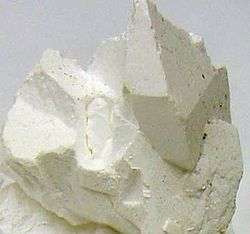Arcanite
| Arcanite | |
|---|---|
|
Arcanite | |
| General | |
| Category | Sulfate mineral |
| Formula (repeating unit) | K2SO4 |
| Strunz classification | 7.AD.05 |
| Crystal system | Orthorhombic |
| Crystal class |
Dipyramidal (mmm) H-M symbol: (2/m 2/m 2/m) |
| Space group | Pmcn |
| Unit cell |
a = 5.77, b = 10.07 c = 7.48 [Å]; Z = 4 |
| Identification | |
| Color | White to colorless, yellow |
| Crystal habit | Tabular crystals, typically in crusts and coatings |
| Twinning | Cyclic on {110} |
| Cleavage | Good on {010} and {001} |
| Mohs scale hardness | 2 |
| Luster | Vitreous |
| Streak | White |
| Diaphaneity | Transparent to translucent |
| Specific gravity | 2.66 |
| Optical properties | Biaxial (+) |
| Refractive index | nα = 1.494 nβ = 1.495 nγ = 1.497 |
| Birefringence | δ = 0.004 |
| 2V angle | Measured: 67° |
| References | [1][2][3] |
Arcanite is a potassium sulfate mineral with formula: K2SO4.
Arcanite was first described in 1845 for an occurrence in old pine railroad ties in the Santa Ana tin mine, Trabuco Canyon, Santa Ana Mountains, Orange County, California, US.[1][3] It has also been reported from hydrothermal deposits in the Cesano geothermal field, Latium, Italy; in bat guano on the Chincha Islands of Peru; and in caves in Western Australia, South Africa and Namibia.[3]
References
This article is issued from Wikipedia - version of the 11/22/2016. The text is available under the Creative Commons Attribution/Share Alike but additional terms may apply for the media files.
